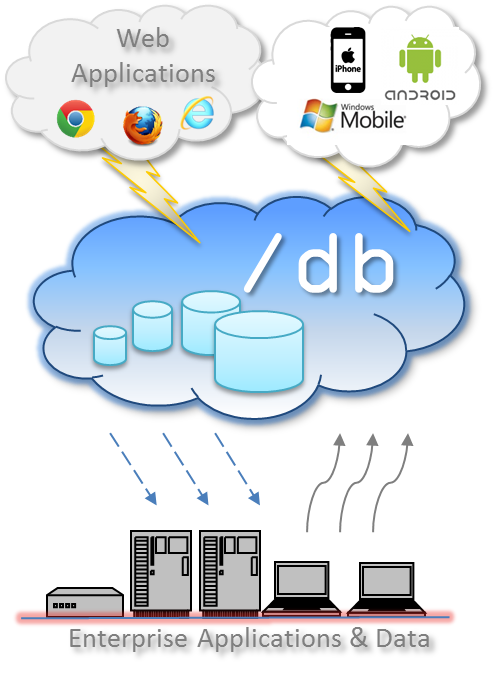SlashDB works on premises as well as in the cloud and offers unique benefits in both environments.
Specific Use Cases
- Connect databases to HTML5 and mobile applications
- Modernize legacy systems for the cloud and microservices
- Create a data hub for data science, reporting, and enterprise data management.
- Securely share your data assets with clients and partners
Generic Use Cases
SlashDB can be applied in four major contexts: cloud to cloud, cloud to ground, ground to cloud, and ground control.
Cloud to Cloud
With the unstoppable growth of online and mobile applications, offering an API in addition to human-readable content has become a necessity. With SlashDB, you can do more:
- Web applications can share data with other websites without needing a hand-coded API.
- Web developers can work with a JSON or an XML API abstraction of the underlying database content.
- Readying your site for the semantic web is easier.
- You can instantly expose your data to search and analysis.
Cloud to Ground
Cloud to ground is also known as the cloud-bursting scenario. Organizations which are outgrowing their database storage capacities look to the cloud to avoid cumbersome hardware management. Here’s how SlashDB enables this transition:
- Host databases in a scalable cloud while keeping your proprietary software and algorithms in-house.
- Connect efficiently and securely using HTTPS.
- Preserve investments already made in relational databases.
- Prepare for future migration to the cloud or for connecting with other mobile and Internet applications.
- Use simple HTTP proxies for caching so that your database servers can operate at optimum performance.
Ground to Cloud
In many industries, data has become the most valuable resource after people. Businesses strive to capitalize on this valuable property, but publishing data is often an expensive undertaking in software development. With SlashDB, your databases are instantly ready for the web:
- Publish data on the web in standard formats such as XML, CSV, and JSON.
- Offer on-demand access instead of bulk file downloads.
- Develop metered pricing models which can be as granular as individual records and fields.
Data vendors seeking new distribution channels are an excellent use case.
Ground Control
The most critical enterprise data is kept in relational databases in proprietary data centers. When installed on premises, SlashDB preserves those database investments while enabling unparalleled accessibility. This scenario is sometimes known as data virtualization, data-as-a-service, or resource-oriented architecture (ROA).
- Multiple databases can be accessed in a uniform way from a central location without copying data to a data warehouse.
- Enterprise application integration becomes simpler and less prone to error because data remain in their original systems.
- Enterprise data management becomes simpler because data entitlement can be based on resources abstracted by URLs.
- Searching databases using natural language queries becomes a reality because intranet search engines can follow links to database content.
- Users are empowered with data thanks to the search function and standard data formats.
- Application-development teams can focus on business-driven problems instead of tedious data-plumbing tasks.
- Queries and data resources can be centrally administered, avoiding duplication of work.
- Java, C#, C++, Python, PERL, Excel/VBA, R, and other tools can seamlessly interact with data resources.

See Also
To see how data vendors, mobile application developers, data scientists and technology architects gain unique benefits from SlashDB, please follow the respective links. You can also learn more about how SlashDB works.

